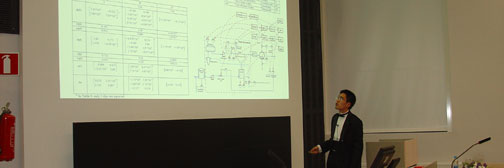| | Year 1998
Jaana KanervoTransient kinetics of hydrogenation reaction
Transient response methods and their applicability in heterogeneously catalysed reaction kinetics were studied in this Master’s thesis. In the transient methods, a dynamic change is introduced into a reactor system, and its response in some reaction quantity is measured. Transient response can be analysed to obtain more kinetic information than what is possible using traditional stationary experiments. A dynamic change can be introduced in flow rate, pressure, temperature or inlet concentration. Usually, in heterogeneously catalysed reactions concentration signals – steps or pulses – are imposed on the inlet stream under isothermic conditions. Transient experiments usually employ flow reactors.
This study consists of two parts. In the literature part, basics of transient kinetics, transient balances, application requirements, different dynamic response methods and mathematical analysis of transient data are considered. In the concentration response methods, a model is formulated by combining the transient mass balances of each species in a reactor to the kinetics of elementary steps. Kinetic parameters are determined by fitting the model to the experimental response data. This gives an opportunity to test different model hypotheses.
In the experimental part, the gas phase hydrogenation of toluene on nickel catalyst is considered. Reaction mechanisms are postulated by dividing the reaction into elementary steps containing adsorption, surface reaction and desorption steps. The models are formed by combining kinetics of the elementary steps with the transient mass balances of a packed bed reactor. Transient kinetic analysis is applied to model the kinetics of the adsorption of hydrogen and methylcyclohexane. The adsorption and desorption rate constants as well as the number of active sites on the catalyst are estimated based on experimental data. Applicability of transient analysis to the hydrogenation reaction is also considered. The experimental work has been carried out in the laboratory of Industrial Chemistry at Helsinki University of Technology using a pulse microcatalytic reactor, the outlet concentration of which has been analysed by a mass spectrometer.
The computations required in the estimation of kinetic parameters are implemented in Matlab environment. Parameter estimation involves an iterative procedure, on each step of which a system of partial differential equations defined by the model is solved, using the current parameter set. Input variables of the model are set equivalent to the input variables of the experiments. The response given by the model is compared with the experimental one and new parameter values for next iteration step are calculated by minimizing the difference between the responses with respect to the parameters to be estimated.
Transient kinetic analysis is suitable for kinetic modeling based on actual reaction mechanism. Compared with traditional methods the methods based on dynamic responses require more complicated computational analysis, but they also offer better opportunities for mechanistic studies with the potential to discriminate between rival model hypotheses.
Deprecated: strlen(): Passing null to parameter #1 ($string) of type string is deprecated in C:\WWWroot\Root\incs\5_theses\theses_new2010.php on line 248
This info last modified 27 Apr 2024 - contact webmaster
|

